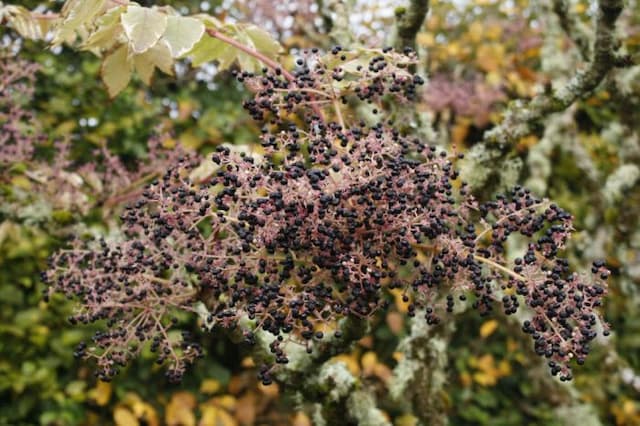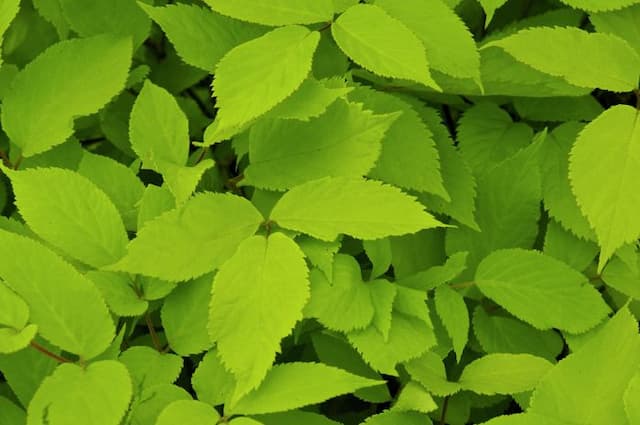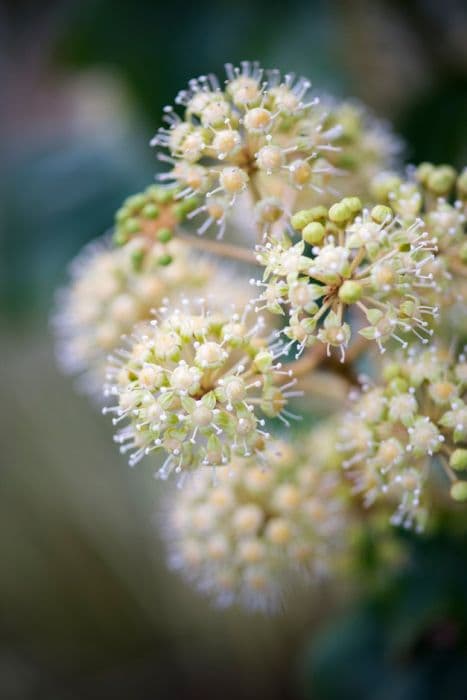English Ivy Hedera helix 'Ivalace'

ABOUT
The Ivalace English Ivy is a captivating plant that draws attention with its distinctive foliage. Its leaves are small, with a luscious deep green hue that can almost appear glossy or waxy. Each leaf is delicately curled, giving it a ruffled look that adds to its charm. The edges of the leaves are irregular, contributing to the plant's intricate texture. These complex, heart-shaped leaves are further highlighted by prominent veins that create a striking contrast to the dark green background. As a climbing or ground-cover plant, the Ivalace English Ivy extends its reach with slender, flexible stems. These stems can cling to surfaces, helping the plant ascend or spread across the ground. The growth habit of the plant adds to its ornamental value, making it a favorite for creating green walls or covering unsightly areas in a garden. The overall impression of the Ivalace English Ivy is one of elegance and refinement, with its unique foliage offering a lush, verdant presence wherever it is situated.
About this plant
 Names
NamesFamily
Araliaceae.
Synonyms
English Ivy, Common Ivy, European Ivy, Ivy.
Common names
Hedera helix 'Ivalace'.
 Toxicity
ToxicityTo humans
English ivy, specifically the Hedera helix 'Ivalace', is considered toxic to humans. Ingesting parts of the plant can lead to various symptoms, including nausea, vomiting, diarrhea, and abdominal pain. In some cases, contact with the sap can also cause topical skin irritation or dermatitis. In severe cases, ingesting large amounts of English ivy can result in more serious health issues, such as difficulty in breathing, fever, or a rash, and may require medical attention.
To pets
English ivy is also toxic to pets, including cats and dogs. If a pet ingests this plant, they can experience symptoms similar to humans, such as vomiting, abdominal pain, hypersalivation, and diarrhea. The plant can also cause topical skin irritation if a pet comes into contact with its sap. In extreme cases, ingestion can lead to severe conditions like difficulty breathing or coma, especially if large amounts are eaten. Pet owners should immediately seek veterinary care if they suspect their pet has ingested English ivy.
 Characteristics
CharacteristicsLife cycle
Perennials
Foliage type
Evergreen
Color of leaves
Green
Height
6-8 feet (1.8-2.4 meters)
Spread
1-3 feet (0.3-0.9 meters)
Plant type
Climber
Hardiness zones
5-9
Native area
Europe
Benefits
 General Benefits
General Benefits- Visual Interest: The curly, shiny leaves of English Ivy 'Ivalace' add texture and depth to gardens and indoor spaces.
- Versatility: It can be grown in a variety of conditions, including as a groundcover, wall climbing plant, or in hanging baskets.
- Easy Care: English Ivy 'Ivalace' is relatively low-maintenance, requiring minimal watering and feeding once established.
- Drought Tolerant: Once established, it can tolerate periods of drought, making it suitable for xeriscaping.
- Temperature Resistant: It's capable of surviving in a range of temperatures, making it suitable for many climates.
- Shade Tolerant: English Ivy 'Ivalace' can grow in shaded areas where other plants may struggle.
- Wildlife Shelter: Provides cover and nesting sites for birds and other wildlife.
- Seasonal Interest: Keeps its foliage year-round, adding greenery to gardens even in winter.
- Soil Erosion Control: Can help prevent soil erosion due to its dense growth habit.
- Architectural Integration: Often used to beautify and integrate with buildings, fences, and other structures in the landscape.
 Medical Properties
Medical Properties- Expectorant: English ivy is traditionally used to help relieve coughs and bronchitis, as it is said to have expectorant properties.
- Anti-inflammatory: Contains saponins that are thought to have anti-inflammatory effects.
- Antispasmodic: The plant is believed to alleviate spasms, particularly in the bronchi.
- Antimicrobial: In vitro studies suggest English ivy may possess antimicrobial properties against certain pathogens.
- Topical treatment for skin conditions: Sometimes used as a topical treatment for burns, itchy skin, and other skin conditions due to its purported soothing effects.
 Air-purifying Qualities
Air-purifying QualitiesThis plant is not specifically known for air purifying qualities.
 Other Uses
Other Uses- Topiary Art: English ivy 'Ivalace' can be trained to grow on wireframes to create living sculptures in gardens and landscaping projects.
- Ground Cover: It provides effective erosion control on slopes due to its dense mat-forming growth habit, preventing soil from being washed away by rain.
- Green Roofing: Because of its hardiness and low maintenance, English ivy 'Ivalace' is used in green roofing, contributing to building insulation and biodiversity.
- Noise Reduction: The dense foliage can help dampen noise when planted against walls along busy streets or highways.
- Privacy Screens: Grown on trellises or fences, it can create a natural privacy barrier for outdoor areas like patios or gardens.
- Educational Tool: English ivy 'Ivalace' can be used in science classes to demonstrate plant growth patterns and climbing mechanisms.
- Craft Materials: The vines and leaves can be used in floral arrangements or to create natural wreaths and other decorative items.
- Camouflage: It can cover unsightly structures, like old tree stumps or utility boxes, blending them into the landscape.
- Wildlife Habitat: English ivy 'Ivalace' provides shelter and nesting sites for birds and small mammals within its dense growth.
- Festive Decor: During the holidays, the vines can be used to wrap around banisters or other structures for a touch of natural greenery.
Interesting Facts
 Feng Shui
Feng ShuiThe English Ivy is not used in Feng Shui practice.
 Zodiac Sign Compitability
Zodiac Sign CompitabilityThe English Ivy is not used in astrology practice.
 Plant Symbolism
Plant Symbolism- Connection: As English Ivy clings and climbs over structures, it signifies strong bonds and connections in relationships and communities.
- Eternal Life: Its evergreen nature represents immortality and the eternal soul, signifying a bond that lasts beyond a lifetime.
- Fidelity: English Ivy's tenacity and ability to stick to surfaces represent faithfulness and loyalty in love and friendship.
- Protection: Historically, people believed English Ivy had the power to ward off evil spirits, giving it a symbolic meaning of safeguarding one's home or person.
- Survival: Due to its robustness and adaptability to different environments, English Ivy symbolizes endurance and the ability to survive difficult conditions.
- Memory and Remembrance: Often found in many old gardens and estates, English Ivy suggests a sense of nostalgia and commemoration of the past.
- Prosperity and Growth: English Ivy's vigorous growth habits symbolize expanding opportunities and flourishing success, often used in business contexts.
 Water
WaterThe English Ivy 'Ivalace' requires consistent moisture and should be watered thoroughly whenever the top inch of soil feels dry to the touch, which usually amounts to once a week. Depending on the environmental conditions, such as temperature and humidity, the frequency may increase; during hot, dry periods, it might need water more than once per week. Provide enough water to moisten the soil entirely, using approximately half a gallon for a medium-sized pot. Ensure proper drainage to prevent waterlogging, which can lead to root rot. During the winter months when the plant is dormant, reduce watering to every other week or less, allowing the soil to dry out slightly between waterings.
 Light
LightEnglish Ivy 'Ivalace' prefers bright, indirect light to maintain its vibrant foliage but can also adapt to low-light conditions. It should not be placed in direct sunlight, as harsh rays can scorch the leaves. A spot near a north- or east-facing window is ideal, offering plenty of light without direct exposure to the harsh afternoon sun. If growing indoors, rotating the plant periodically ensures even growth on all sides.
 Temperature
TemperatureEnglish Ivy 'Ivalace' thrives in temperatures between 50°F and 70°F, which are typical indoor conditions. It can survive in temperatures as low as 30°F, but growth may be impacted, and frost can damage the foliage. To encourage vigorous growth, maintain a consistent indoor temperature and avoid sudden temperature drops or drafty areas near windows and doors.
 Pruning
PruningPruning English Ivy 'Ivalace' maintains its shape, encourages new growth, and prevents it from becoming too leggy. It should be pruned in the spring or early summer, taking care not to remove more than one-third of the plant at a time. Snip below leaf nodes to promote bushier growth and remove any dead or damaged leaves to keep the plant healthy. Regular pruning also helps control its size if you are growing it indoors as a houseplant.
 Cleaning
CleaningAs needed
 Soil
SoilEnglish Ivy 'Ivalace' thrives in well-draining, loamy soil with a pH of 6.0 to 7.5. The best soil mix can be made by combining two parts peat or coco coir, one part perlite, and one part garden soil to ensure adequate drainage and aeration.
 Repotting
RepottingEnglish Ivy 'Ivalace' should be repotted every two to three years to prevent becoming root-bound and to replenish its soil with fresh nutrients. Choose a container one size larger than the current one for optimal growth.
 Humidity & Misting
Humidity & MistingEnglish Ivy 'Ivalace' prefers moderate to high humidity levels, ideally between 40% and 60%. Mist the leaves regularly or place a humidifier nearby to maintain these conditions without directly affecting the plant's watering schedule.
 Suitable locations
Suitable locationsIndoor
Place English Ivy 'Ivalace' in bright, indirect light and keep soil moist.
Outdoor
Plant English Ivy 'Ivalace' in shaded areas with rich soil.
Hardiness zone
5-11 USDA
 Life cycle
Life cycleHedera helix 'Ivalace', commonly known as English Ivy 'Ivalace', begins its life as a seed, often dispersed by birds who eat the berries. Once the seed germinates in suitable moist and shaded conditions, it enters the juvenile vegetative stage, characterized by rapid vine growth and lobed leaves which can last for several years. During this stage, English Ivy 'Ivalace' vigorously climbs or spreads across the ground, exhibiting its notable dark green, crinkled, and lustrous leaves. After reaching maturity, which may take a few years, the plant produces small, inconspicuous flowers in clusters in the late summer to fall, signaling the reproductive stage. Following pollination, the flowers develop into small, dark berries through the winter, which are consumed and dispersed by birds, thus completing its reproductive cycle. In ideal conditions, English Ivy 'Ivalace' can be long-lived, often persisting for many years and potentially becoming invasive if not properly managed.
 Propogation
PropogationPropogation time
Spring-Early Summer
The most popular method for propagating English ivy 'Ivalace' is through stem cuttings. This can be done at any time of the year, but the best time is during spring or early summer when the plant is actively growing. To propagate, one would take a stem cutting about 4 to 6 inches (10 to 15 centimeters) long, ensuring there are at least 2 or 3 leaves left on the cutting. Next, the cut end is dipped in rooting hormone to promote root development and then planted in a pot filled with a mixture of peat and perlite or sand to provide good drainage. The cutting should be kept moist but not overly wet, and in a bright, indirect light setting to root successfully. Roots typically develop within a few weeks after which the new plant can be transferred to a permanent location.









